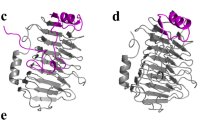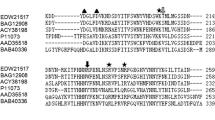Abstract
Biotechnological applications of microbial pectate lyases (Pels) in plant fiber processing are promising, eco-friendly substitutes for conventional chemical degumming processes. However, to potentiate the enzymes’ use for industrial applications, resolving the molecular structure to elucidate catalytic mechanisms becomes necessary. In this manuscript, we report the high resolution (1.45 Å) crystal structure of pectate lyase (pelN) from Paenibacillus sp. 0602 in apo form. Through sequence alignment and structural superposition with other members of the polysaccharide lyase (PL) family 1 (PL1), we determined that pelN shares the characteristic right-handed β-helix and is structurally similar to other members of the PL1 family, while exhibiting key differences in terms of catalytic and substrate binding residues. Then, based on information from structure alignments with other PLs, we engineered a novel pelN. Our rational design yielded a pelN mutant with a temperature for enzymatic activity optimally shifted from 67.5 to 60 °C. Most importantly, this pelN mutant displayed both higher specific activity and ramie fiber degumming ability when compared with the wild-type enzyme. Altogether, our rational design method shows great potential for industrial applications. Moreover, we expect the reported high-resolution crystal structure to provide a solid foundation for future rational, structure-based engineering of genetically enhanced pelNs.







Similar content being viewed by others
References
Abbott DW, Boraston AB (2007) A family 2 pectate lyase displays a rare fold and transition metal-assisted beta-elimination. J Biol Chem 282(48):35328–35336. doi:10.1074/jbc.M705511200
Abbott DW, Gilbert HJ, Boraston AB (2010) The active site of Oligogalacturonate lyase provides unique insights into cytoplasmic oligogalacturonate beta-elimination. J Biol Chem 285(50):39029–39038. doi:10.1074/jbc.M110.153981
Adams PD, Grosse-Kunstleve RW, Hung LW, Ioerger TR, McCoy AJ, Moriarty NW, Read RJ, Sacchettini JC, Sauter NK, Terwilliger TC (2002) PHENIX: building new software for automated crystallographic structure determination. Acta Crystallogr D 58:1948–1954. doi:10.1107/S0907444902016657
Akita M, Suzuki A, Kobayashi T, Ito S, Yamane T (2001) The first structure of pectate lyase belonging to polysaccharide lyase family 3. Acta Crystallogr D 57:1786–1792. doi:10.1107/S0907444901014482
Alahuhta M, Chandrayan P, Kataeva I, Adams MW, Himmel ME, Lunin VV (2011) A 1.5 Å resolution X-ray structure of the catalytic module of Caldicellulosiruptor bescii family 3 pectate lyase. Acta Crystallogr Sect F Struct Biol Cryst Commun 67(Pt 12):1498–1500. doi:10.1107/S1744309111038449
Basu S, Saha MN, Chattopadhyay D, Chakrabarti K (2009) Large-scale degumming of ramie fibre using a newly isolated Bacillus pumilus DKS1 with high pectate lyase activity. J Ind Microbiol Biotechnol 36(2):239–245. doi:10.1007/s10295-008-0490-y
Bruhlmann F, Leupin M, Erismann KH, Fiechter A (2000) Enzymatic degumming of ramie bast fibers. J Biotechnol 76(1):43–50. doi:10.1016/S0168-1656(99)00175-3
Charnock SJ, Brown IE, Turkenburg JP, Black GW, Davies GJ (2002) Convergent evolution sheds light on the anti-beta-elimination mechanism common to family 1 and 10 polysaccharide lyases. P Natl Acad Sci USA 99(19):12067–12072. doi:10.1073/pnas.182431199
Creze C, Castang S, Derivery E, Haser R, Hugouvieux-Cotte-Pattat N, Shevchik VE, Gouet P (2008) The crystal structure of pectate lyase PelI from soft rot pathogen Erwinia chrysanthemi in complex with its substrate. J Biol Chem 283(26):18260–18268. doi:10.1074/jbc.M709931200
Emsley P, Cowtan K (2004) Coot: model-building tools for molecular graphics. Acta Crystallogr D 60:2126–2132. doi:10.1107/S0907444904019158
Garron ML, Cygler M (2010) Structural and mechanistic classification of uronic acid-containing polysaccharide lyases. Glycobiology 20(12):1547–1573. doi:10.1093/glycob/cwq122
Gouet P, Robert X, Courcelle E (2003) ESPript/ENDscript: extracting and rendering sequence and 3D information from atomic structures of proteins. Nucleic Acids Res 31(13):3320–3323
Gummadi SN, Kumar DS (2006) Optimization of chemical and physical parameters affecting the activity of pectin lyase and pectate lyase from Debaryomyces nepalensis: a statistical approach. Biochem Eng J 30(2):130–137. doi:10.1016/j.bej.2006.02.014
Henrissat B, Heffron SE, Yoder MD, Lietzke SE, Jurnak F (1995) Functional implications of structure-based sequence alignment of proteins in the extracellular pectate lyase superfamily. Plant Physiol 107(3):963–976. doi:10.1104/Pp.107.3.963
Herron SR, Scavetta RD, Garrett M, Legner M, Jurnak F (2003) Characterization and implications of Ca2+ binding to pectate lyase C. J Biol Chem 278(14):12271–12277. doi:10.1074/jbc.M209306200
Huang WJ, Matte A, Li YG, Kim YS, Linhardt RJ, Su HS, Cygler M (1999) Crystal structure of chondroitinase B from Flavobacterium heparinum and its complex with a disaccharide product at 1.7 Å resolution. J Mol Biol 294(5):1257–1269. doi:10.1006/jmbi.1999.3292
Jayani RS, Saxena S, Gupta R (2005) Microbial pectinolytic enzymes: a review. Process Biochem 40(9):2931–2944. doi:10.1016/j.procbio.2005.03.026
Jenkins J, Shevchik VE, Hugouvieux-Cotte-Pattat N, Pickersgill RW (2004) The crystal structure of pectate lyase Pel9A from Erwinia chrysanthemi. J Biol Chem 279(10):9139–9145. doi:10.1074/jbc.M311390200
Klug-Santner BG, Schnitzhofer W, Vrsanska M, Weber J, Agrawal PB, Nierstrasz VA, Guebitz GM (2006) Purification and characterization of a new bioscouring pectate lyase from Bacillus pumilus BK2. J Biotechnol 121(3):390–401. doi:10.1016/j.jbiotec.2005.07.019
Li X, Wang H, Zhou C, Ma Y, Li J, Song J (2014) Cloning, expression and characterization of a pectate lyase from Paenibacillus sp. 0602 in recombinant Escherichia coli. BMC Biotechnol 14:18. doi:10.1186/1472-6750-14-18
Liang C, Gui X, Zhou C, Xue Y, Ma Y, Tang SY (2015) Improving the thermoactivity and thermostability of pectate lyase from Bacillus pumilus for ramie degumming. Appl Microbiol Biotechnol 99(6):2673–2682. doi:10.1007/s00253-014-6091-y
Lietzke SE, Scavetta RD, Yoder MD, Jurnak F (1996) The refined three-dimensional structure of pectate lyase E from Erwinia chrysanthemi at 2.2 Å resolution. Plant Physiol 111:73–92
McLean R, Hobbs JK, Suits MD, Tuomivaara ST, Jones DR, Boraston AB, Abbott DW (2015) Functional analyses of resurrected and contemporary enzymes illuminate an evolutionary path for the emergence of exolysis in polysaccharide lyase family 2. J Biol Chem 290(35):21231–21243. doi:10.1074/jbc.M115.664847
Minor W, Cymborowski M, Otwinowski Z, Chruszcz M (2006) HKL-3000: the integration of data reduction and structure solution—from diffraction images to an initial model in minutes. Acta Crystallogr D Biol Crystallogr 62(Pt 8):859–866. doi:10.1107/S0907444906019949
Ouattara HG, Reverchon S, Niamke SL, Nasser W (2010) Biochemical properties of pectate lyases produced by three different Bacillus strains isolated from fermenting cocoa beans and characterization of their cloned genes. Appl Environ Microb 76(15):5214–5220. doi:10.1128/Aem.00705-10
Pickersgill R, Jenkins J, Harris G, Nasser W, Robert-Baudouy J (1994) The structure of Bacillus subtilis pectate lyase in complex with calcium. Nat Struct Biol 1(10):717–723
Potterton E, Briggs P, Turkenburg M, Dodson E (2003) A graphical user interface to the CCP4 program suite. Acta Crystallogr D 59:1131–1137. doi:10.1107/S0907444903008126
Scavetta RD, Herron SR, Hotchkiss AT, Kita N, Keen NT, Benen JA, Kester HC, Visser J, Jurnak F (1999) Structure of a plant cell wall fragment complexed to pectate lyase C. Plant Cell 11(6):1081–1092
Seyedarabi A, To TT, Ali S, Hussain S, Fries M, Madsen R, Clausen MH, Teixteira S, Brocklehurst K, Pickersgill RW (2010) Structural insights into substrate specificity and the anti beta-elimination mechanism of pectate lyase. Biochemistry-Us 49(3):539–546. doi:10.1021/bi901503g
Thompson JD, Gibson TJ, Plewniak F, Jeanmougin F, Higgins DG (1997) The CLUSTAL_X windows interface: flexible strategies for multiple sequence alignment aided by quality analysis tools. Nucleic Acids Res 25(24):4876–4882
Yamasaki M, Moriwaki S, Miyake O, Hashimoto W, Murata K, Mikami B (2004) Structure and function of a hypothetical Pseudomonas aeruginosa protein PA1167 classified into family PL-7: a novel alginate lyase with a beta-sandwich fold. J Biol Chem 279(30):31863–31872. doi:10.1074/jbc.M402466200
Yoder MD, Jurnak F (1995a) Protein motifs. 3. The parallel beta helix and other coiled folds. FASEB journal : Official Publication of the Federation of American Societies for Experimental Biology 9(5):335–342
Yoder MD, Jurnak F (1995b) The refined three-dimensional structure of pectate lyase C from Erwinia chrysanthemi at 2.2 angstrom resolution (implications for an enzymatic mechanism). Plant Physiol 107(2):349–364
Yoder MD, Lietzke SE, Jurnak F (1993) Unusual structural features in the parallel beta-helix in pectate lyases. Structure 1(4):241–251. doi:10.1016/0969-2126(93)90013-7
Yoon HJ, Hashimoto W, Miyake O, Murata K, Mikami B (2001) Crystal structure of alginate lyase A1-III complexed with trisaccharide product at 2.0 Å resolution. J Mol Biol 307(1):9–16. doi:10.1006/jmbi.2000.4509
Zheng YY, Huang CH, Liu WT, Ko TP, Xue YF, Zhou C, Guo RT, Ma YH (2012) Crystal structure and substrate-binding mode of a novel pectate lyase from alkaliphilic Bacillus sp N16-5. Biochem Bioph Res Co 420(2):269–274. doi:10.1016/j.bbrc.2012.02.148
Zhou ZP, Zhao SZ, Wang SQ, Li XM, Su L, Ma YH, Li J, Song JN (2015) Extracellular overexpression of Chitosanase from Bacillus sp TS in Escherichia coli. Appl Biochem Biotech 175(7):3271–3286. doi:10.1007/s12010-015-1494-5
Zou MY, Li XZ, Shi WJ, Guo FF, Zhao J, Qu YB (2013) Improved production of alkaline polygalacturonate lyase by homologous overexpression pelA in Bacillus subtilis. Process Biochem 48(8):1143–1150. doi:10.1016/j.procbio.2013.05.023
Acknowledgements
The authors thank Dr. Yuzhong Zhang for his kind help during data collection and Jie Zhang for assistance with structure determination. This work was supported, in part, by grants from the Hundred Talents Program of the Chinese Academy of Sciences (CAS), the Knowledge Innovation Program of CAS (KSCX2-EW-G-8), and the Tianjin Municipal Science & Technology Commission (10ZCKFSY05600). T.M. L and A.L. would like to thank the Isaac Newton Institute for Mathematical Sciences for support through EPSRC Grant No. EP/K032208/1. J.S. is a recipient of the Hundred Talents Program of CAS. J.L. is an NHMRC Senior Research Fellow.
This article does not contain any studies with human participants or animals.
Author information
Authors and Affiliations
Corresponding author
Ethics declarations
Conflict of interest
The authors declare that they have no competing interest.
Rights and permissions
About this article
Cite this article
Zhou, Z., Liu, Y., Chang, Z. et al. Structure-based engineering of a pectate lyase with improved specific activity for ramie degumming. Appl Microbiol Biotechnol 101, 2919–2929 (2017). https://doi.org/10.1007/s00253-016-7994-6
Received:
Revised:
Accepted:
Published:
Issue Date:
DOI: https://doi.org/10.1007/s00253-016-7994-6




